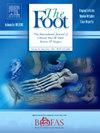Treatment of Juvenile Hallux Valgus with a Simple, Effective, Rapid, and Inexpensive (SERI) technique: A systematic review and meta-analysis
Q2 Health Professions
引用次数: 0
Abstract
Juvenile hallux valgus presents pediatric challenges ranging from cosmetic to functional issues, with multiple surgical management strategies reported. The simple, effective, rapid, and inexpensive (SERI) technique has gained attention for its potential to offer effective correction with minimal complications. Its effectiveness in younger patients is still uncertain. This systematic review and meta-analysis evaluates the outcomes of SERI in treating Juvenile hallux valgus. Medline, Embase, Cochrane CENTRAL, CINAHL Complete, and SPORTDiscus databases were searched from inception to April 5, 2024, for studies on SERI outcomes in JHV. Following the PRISMA/R-AMSTAR guidelines and Cochrane Handbook for Systematic Reviews of Interventions, studies were screened, and data were collected on demographics, radiographic measurements, patient-reported outcomes, and complications. A meta-analysis using random-effects models to estimate study weights was performed. Five studies comprising 153 patients (208 feet) treated with SERI met inclusion criteria. Mean age was 14.6 (±4.3) years; with 80 % female patients and a mean follow-up of 43 months. Postoperative mean hallux valgus angle improved from 26.1° (±4.8) to 10.5°(±3.5), intermetatarsal angle from 14.2° (±0.6) to 6.8 (±1.7), and distal metatarsal articular angle from 12.4° (±5.9) to 4.9° (±3.1). The American Orthopedic Foot & Ankle Society (AOFAS) scores achieved the minimal clinically important difference in all studies. Minor complications were documented without significant long-term effects. The SERI technique appears effective and safe for treating juvenile hallux valgus, leading to significant improvements in radiographic measurements and patient outcomes.
Level of Clinical Evidence
Level 3
一种简单、有效、快速、廉价(SERI)技术治疗青少年拇外翻:一项系统综述和荟萃分析
青少年拇外翻呈现儿科挑战,从美容到功能问题,有多种外科治疗策略报道。简单、有效、快速和廉价(SERI)技术因其潜在的以最小的并发症提供有效的矫正而受到关注。它对年轻患者的有效性仍不确定。本系统综述和荟萃分析评估了SERI治疗青少年拇外翻的结果。Medline, Embase, Cochrane CENTRAL, CINAHL Complete和SPORTDiscus数据库从建立到2024年4月5日,检索了关于JHV的SERI结局的研究。根据PRISMA/R-AMSTAR指南和Cochrane干预措施系统评价手册,对研究进行筛选,并收集人口统计学、放射学测量、患者报告的结果和并发症的数据。采用随机效应模型进行meta分析来估计研究权重。接受SERI治疗的153例患者(208英尺)的5项研究符合纳入标准。平均年龄14.6(±4.3)岁;其中女性患者占80% %,平均随访43个月。术后平均拇外翻角由26.1°(±4.8)提高到10.5°(±3.5),跖间角由14.2°(±0.6)提高到6.8°(±1.7),跖远端关节角由12.4°(±5.9)提高到4.9°(±3.1)。美国骨科足踝关节学会(AOFAS)评分在所有研究中取得了最小的临床重要差异。记录的轻微并发症无明显的长期影响。SERI技术治疗青少年拇外翻有效且安全,在影像学测量和患者预后方面有显著改善。临床证据水平:3级
本文章由计算机程序翻译,如有差异,请以英文原文为准。
求助全文
约1分钟内获得全文
求助全文
来源期刊

Foot
Health Professions-Podiatry
CiteScore
2.00
自引率
0.00%
发文量
37
期刊介绍:
The Foot is an international peer-reviewed journal covering all aspects of scientific approaches and medical and surgical treatment of the foot. The Foot aims to provide a multidisciplinary platform for all specialties involved in treating disorders of the foot. At present it is the only journal which provides this inter-disciplinary opportunity. Primary research papers cover a wide range of disorders of the foot and their treatment, including diabetes, vascular disease, neurological, dermatological and infectious conditions, sports injuries, biomechanics, bioengineering, orthoses and prostheses.
 求助内容:
求助内容: 应助结果提醒方式:
应助结果提醒方式:


